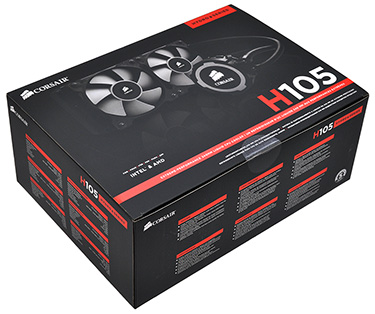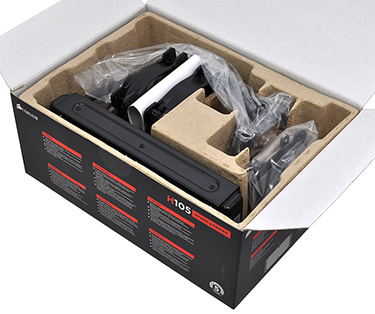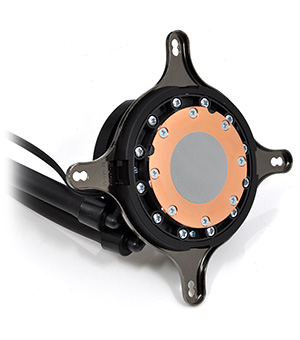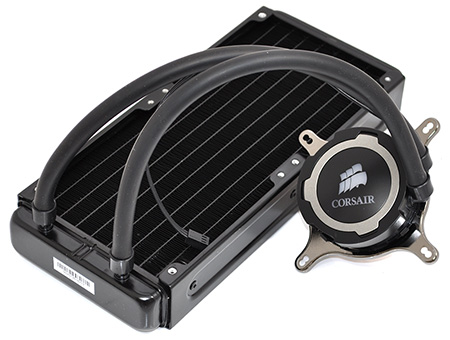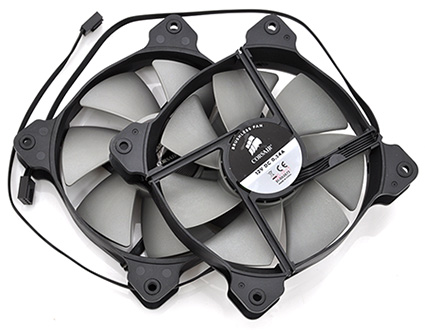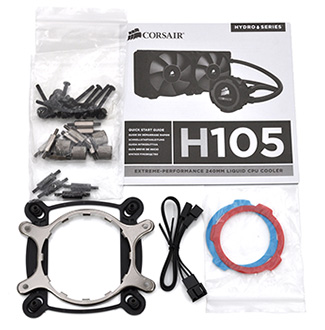Introduction
Corsair has launched a dizzying array of Hydro Series coolers since the days of the H50 back in 2009, and it is fair to say the products have matured nicely in the subsequent years. The recently-reviewed H75 is a prime example: cutting away many of the frills, it's extremely easy to install, widely compatible with today's chassis, quiet in use and able to cool a hot-running, overclocked CPU.
The Hydro Series H75 is probably the all-in-one, closed-loop solution we'd lean toward for a high-end PC build, but it isn't the only new option in Corsair's liquid-cooled stable. Launched alongside the 120mm unit is a 240mm big brother dubbed the Hydro Series H105.
Keeping plenty in common with its smaller sibling, the H105 is essentially the same pump attached to a larger 240mm radiator that promises even better heat dissipation. Of course, that extra level of performance does come at a cost. While the Hydro Series H75 can be yours for under £65, the H105 will set you back somewhere in the region of £90.
A near-40-per-cent increase in price is substantial, so straight away this is a cooler that is geared primarily at enthusiast users who demand maximum performance irrespective of cost. With that in mind, Corsair has made a couple of tweaks to help make the H105 stand out from its older 240mm option, the H100i.
The key upgrade is the radiator itself. Whereas last year's H100i shipped with a 240mm unit measuring 27mm thick, the H105 ups the ante with a chunkier, 38mm-thick rad. That extra bit of depth is designed to increase cooling performance while maintaining compatibility with a standard 240mm mount. You shouldn't, therefore, have much trouble installing the H105 in a high-end chassis: that's something you couldn't say about the 280mm H110.
Compatibility and ease of use is of paramount importance to an all-in-one liquid cooler, and Corsair's new range seems to be all about getting the basics right. There's no 'Link' connectivity, no unnecessary fan hub, and from the moment you open the box, everything is designed to be simple and straightforward.
The radiator is pre-attached to the pump via a pair of flexible rubber tubes, and the pump itself is similar to the low-profile unit that is featured in the H75. Corsair's still using a copper coldplate with a microfin design and pre-applied paste, but this time around the company logo is fitted with a white backlit LED, and the silver ring is interchangeable - blue and red alternatives are included in the box.
Speaking of which, box contents look and feel familiar, too. A pair of SP120L fans are bundled as standard, as is a Y-splitter cable and mounting kits for the latest Intel and AMD sockets. Everything you need to get started, but Corsair still chooses not to include any spare thermal paste, which makes subsequent installations more tricky than they ought to be.
Both fans are wired to four-pin PWM connectors, yet while they appear identical to the duo bundled with the H75, they're actually quite different. The fans attached to Corsair's 120mm rad are 0.24A units that run at speeds of up to 2,000RPM. For the 240mm H105, the bundled duo have been upgraded to 0.34A units, taking maximum fan speed up to 2,700RPM. The extra airflow will no doubt emphasise the H105's cooling superiority, but as we'll demonstrate a little later in the review, it does have a negative impact on noise.
And that's the question that needs answering here: can the H105 offer better performance than the H75 while being just as enjoyable to use? Maybe not. First and foremost, the larger radiator needs a spacious chassis. Even in a big Graphite Series 600T, installation is a real squeeze - our setup has the radiator touching the heatsinks on a Gigabyte Z87 motherboard, and the auxiliary CPU power connector, located on the top-left corner of the board, had to be severely squashed in order for the radiator to fit.
Installation isn't quite as straightforward as it was for the H75, and even once the radiator is in place, you need to find additional room for the two 120mm fans. Our memory modules prevented the fans from being installed inside the chassis, so we had the fans setup as intakes within the roof of the 600T.
You shouldn't have any problems if you're building into a full-tower case - you may even have room to attach another two fans in a push/pull configuration - and once the radiator and fans are sandwiched in place, it's plain sailing from here on in. A backplate is attached to the rear of the motherboard using four standoffs, and the pump is securely held in place with four cross-head thumbscrews.
One thing to be aware of are the interchangeable rings. Corsair suggests prying them out using a flat-head screwdriver, but in doing so we slipped and managed to catch the top of the pump. There's now a scratch in the black paint, allowing the backlight to bleed through - do be careful when changing the rings, as it's a horrible way to spoil a £90 cooler.
How the cooler fits and how the cooler looks is entirely dependant on the host chassis, but in our opinion the H75 is the easier going of the two. Still, the reasoning behind these units is to cool, first and foremost, so let's now find out how the H105 fares in our benchmarks.






